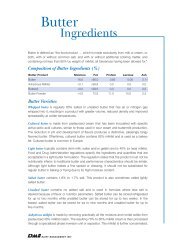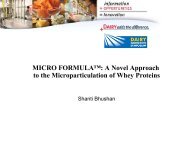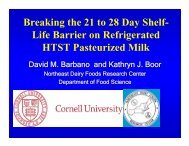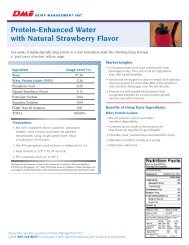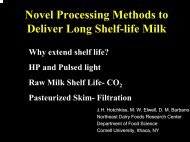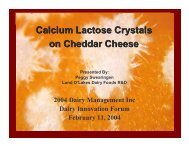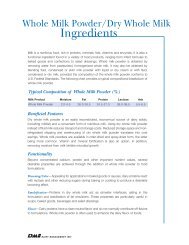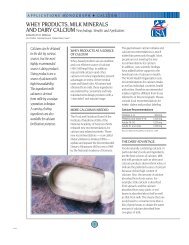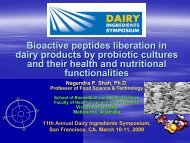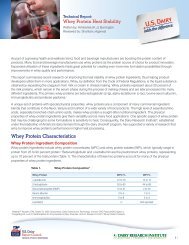Emerging Milk Protein Opportunities - InnovateWithDairy.com
Emerging Milk Protein Opportunities - InnovateWithDairy.com
Emerging Milk Protein Opportunities - InnovateWithDairy.com
You also want an ePaper? Increase the reach of your titles
YUMPU automatically turns print PDFs into web optimized ePapers that Google loves.
S P E C I A L R E P O R T May 2010<br />
<strong>Emerging</strong> <strong>Milk</strong><br />
<strong>Protein</strong> <strong>Opportunities</strong><br />
The latest research on applications,<br />
processing and markets<br />
Table of Contents<br />
Page 2 Global Demand for Dairy <strong>Protein</strong><br />
on the Rise<br />
Page 2 Products That Perform: <strong>Milk</strong> Fractions Help<br />
Manufacturers Develop High-<strong>Protein</strong> Foods<br />
Page 4 Now High-<strong>Protein</strong> Products<br />
can Taste Better<br />
Page 4 Membrane Options Create<br />
new <strong>Protein</strong> <strong>Opportunities</strong><br />
Page 5 Enhanced Functionality<br />
for <strong>Protein</strong>-Packed Products<br />
Page 6 Fractionating With Charged<br />
UF Membranes<br />
Page 6 Process Innovation Offers Strong<br />
Market Potential With Beta-Casein<br />
Page 7 Enriched <strong>Protein</strong> Fractions via<br />
Supercritical Carbon Dioxide<br />
Page 8 Dairy Research Centers Support<br />
Product Innovation<br />
Market <strong>Opportunities</strong><br />
for New-Generation<br />
Dairy Ingredients<br />
<strong>Milk</strong> is a rich source of nutrients that can be fractionated<br />
into a wide range of <strong>com</strong>ponents and used as ingredients to<br />
boost the protein value of foods and beverages. Next-generation<br />
dairy ingredients gaining attention are whey proteins isolated<br />
directly from milk. Research indicates that these whey proteins<br />
have both similar and different attributes as traditional whey<br />
proteins isolated from cheese whey.<br />
Due to their nutritional and functional benefits, whey protein<br />
ingredients expand the possibilities to formulate protein-packed<br />
foods and beverages that consumers demand.<br />
Health and wellness<br />
<strong>Protein</strong> plays many important roles, such as repairing the<br />
body’s cells; building and repairing muscles; helping build and<br />
maintain bones; and helping control many metabolic processes.<br />
Food and beverage manufacturers are boosting the protein<br />
content of products to tap into the growing health and<br />
wellness trend. According to a 2009 Mintel survey,<br />
86 percent of respondents indicated that eating healthy<br />
is very or somewhat important to them. 1<br />
Currently, many food and beverage manufacturers use whey<br />
proteins as the protein source of choice for product innovation.<br />
According to Mintel, 4,100 new food and beverage products<br />
containing whey protein ingredients were introduced to the<br />
U.S. retail market from 2003 to 2009. 2 These products include<br />
nutrition and energy bars, ready-to-drink beverages, smoothies,<br />
beverage mixes, meal replacements, cereal and yogurt.<br />
Feeling full and managing weight<br />
One benefit to protein-rich products is their satiety effect.<br />
A higher protein diet can help people feel fuller longer, which may<br />
help eliminate the desire to reach for unhealthy snacks between<br />
meals. “Consuming more foods with added whey protein is a simple<br />
way to increase protein intake and help achieve a higher protein diet<br />
for satiety benefits,” says Matt Pikosky, Ph.D., R.D., FACN, director of<br />
research transfer at Dairy Management Inc. (DMI).<br />
According to a 2008 survey conducted by NPD Group for DMI,<br />
67 percent of consumers stated that feeling full is important<br />
when trying to lose weight and two-thirds believe that satiety<br />
is important in their food and beverage choices. 3 Research<br />
continues to uncover the role whey protein plays in satiety<br />
benefits to help consumers manage their weight and avoid<br />
between-meal snacking. (continued on Page 8)
Global Demand for Dairy<br />
<strong>Protein</strong> on the Rise<br />
Worldwide, protein consumption is increasing, and there<br />
are multiple reasons for this increase.<br />
As economies create wealth, there is an increased consumption<br />
of animal protein, including dairy, which is a higher-quality protein<br />
than many plant-based protein sources. In developing countries,<br />
protein is used to improve basic nutritional quality for its citizens.<br />
These countries use whey proteins for applications such as infant<br />
formula, canned milk, dairy products and baked goods.<br />
Developed countries seek protein to improve health, wellness<br />
and performance. “These countries are looking for foods that<br />
can deliver specific health benefits,” says Phil Tong, Ph.D.,<br />
director of the Dairy Products Technology Center at California<br />
Polytechnic State University in San Luis Obispo, Calif. “As a<br />
result, the functional food segment of health and wellness foods<br />
has been steadily increasing over the past few years, and whey<br />
protein has be<strong>com</strong>e a choice ingredient for those products.”<br />
According to Mintel International, functional food and beverage<br />
product introductions worldwide grew from 1,566 products in<br />
2005 to 5,753 products in 2009.<br />
More mouths to feed<br />
Population growth worldwide also is a factor in increased<br />
protein demand. In many countries, the population is growing<br />
faster than its own dairy production can handle for the<br />
immediate future, requiring them to find international sources<br />
for dairy protein.<br />
Plus, the growing middle class worldwide will continue to<br />
be a factor in the rising demand for protein. There will be an<br />
estimated additional 800 million middle-class consumers<br />
worldwide by 2030, the majority of that growth <strong>com</strong>ing from<br />
China, India and Southeast Asia, 7 according to research<br />
conducted by Bain & Company on behalf of the Innovation<br />
Center for U.S. Dairy, which is supported and staffed by Dairy<br />
Management Inc. <br />
Functional FUNCTIONAL food FOOD & beverage BEVERAGE INTRODUCTIONS introductions WORLDWIDE worldwide<br />
Number of Product Launches<br />
6000<br />
4000<br />
2000<br />
The growing middle class worldwide<br />
will continue to be a factor in the rising<br />
demand for protein.<br />
“As countries continue to grow and look for ways to improve<br />
the overall health of their citizens, we can expect their demand<br />
for whey protein to increase as well,” says Vikki J. Nicholson,<br />
vice president of U.S. Manufacturing and Ingredients Marketing<br />
at the U.S. Dairy Export Council. “The United States has a great<br />
opportunity to provide a significant portion of the global whey<br />
protein supply.”<br />
Products That Perform:<br />
<strong>Milk</strong> Fractions Help<br />
Manufacturers Develop<br />
Higher-<strong>Protein</strong> Foods<br />
Bland flavor and aroma, excellent foaming characteristics<br />
and low turbidity are just some of the benefits of whey proteins<br />
derived directly from milk, appealing to makers of proteinenhanced<br />
food and beverage products, according to researchers<br />
at the Wisconsin Center for Dairy Research (WCDR), located at<br />
the University of Wisconsin-Madison.<br />
“Whey proteins derived directly from milk are new-generation<br />
dairy ingredients that hold great potential for foods and<br />
beverages formulated with high concentrations of protein,” says<br />
K.J. Burrington, coordinator of the Dairy Ingredients Applications<br />
Laboratory at the WCDR. “Promising applications include sports<br />
and nutritional bars and beverages, baked goods, whipped<br />
confectionery items and snack foods.”<br />
The key attributes of whey proteins derived directly from milk<br />
<strong>com</strong>e from the nature of the production process. The end<br />
product is more consistent because it has not undergone the<br />
cheesemaking process, which inherently adds certain variables,<br />
such as differing cheese types, rennet enzyme, colors and starter<br />
cultures. In addition, the process of fractionating whey proteins<br />
directly from milk requires fewer heat pasteurization steps, which<br />
reduces protein denaturation and preserves product solubility.<br />
0<br />
2005 2006 2007 2008 2009<br />
Source: Mintel GNPD<br />
7<br />
Bain & Company, Dairy Globalization – Threats, <strong>Opportunities</strong> and Implications, 2009. Research<br />
conducted in association with the Innovation Center for U.S. Dairy’s Globalization Task Force.<br />
2 <strong>Milk</strong> <strong>Protein</strong> Fractionation<br />
<strong>Opportunities</strong>
The whey proteins derived directly from milk also contain less<br />
than 1 percent fat, even when concentrated to as high as<br />
80 percent protein. That accounts for their bland flavor, low turbidity<br />
in solution, foaming capability and stability during storage.<br />
“Being low in milkfat and phospholipids, whey proteins isolated<br />
directly from milk have low susceptibility to oxidation,” notes<br />
John Lucey, Ph.D., professor of food science at the University of<br />
Wisconsin-Madison and researcher at the WCDR. “Therefore its<br />
flavor tends to remain consistent even after prolonged storage.”<br />
Value-added ingredient<br />
Whey proteins derived directly from milk serve well as a highvalue-added<br />
ingredient for products that have nutritional targets.<br />
The highest-potential applications are for products in which<br />
whey protein is added for nutritional fortification of functional<br />
foods (6 percent to 7 percent protein). Substantial amounts of<br />
these whey proteins can be added with minimal effect on flavor,<br />
aroma and appearance.<br />
Benefits for beverages<br />
Burrington considers beverages a very promising application<br />
because consumers are especially sensitive to flavor and aroma<br />
in drinks. “In more highly flavored items like cookies and energy<br />
bars, the mild dairy flavor in whey proteins isolated from cheese<br />
whey usually <strong>com</strong>plements the taste,” she says.<br />
“On the other hand, in beverages, bland flavor<br />
in a protein concentrate is a positive attribute,”<br />
Burrington says. “Sensory research indicates<br />
that consumers readily detect unwanted<br />
flavors and aromas that they do not expect<br />
in a beverage.”<br />
Furthermore, with low turbidity and<br />
high solubility, whey proteins derived<br />
directly from milk can be added to<br />
clear beverages – like sports drinks,<br />
flavored waters, vitamin waters and<br />
some juices – with little or no effect<br />
on their appearance.<br />
Expanding functional foods<br />
As consumers continue to look for nutritionally enhanced food<br />
options, manufacturers can find opportunities to add protein to<br />
a wider array of foods. The bland flavor profile of whey proteins<br />
derived directly from milk also would work well as a proteinenhancer<br />
in mild-flavored foods such as yogurts, flavored milks,<br />
smoothies, white sauces and some soups.<br />
Breaking away from eggs<br />
The foaming properties of whey proteins derived directly from<br />
milk also create potential for baked goods and whipped products<br />
that traditionally rely on eggs for foaming and whipping.<br />
“Egg is currently the dominant ingredient for those applications,<br />
but whey proteins derived directly from milk are viable partial<br />
replacements for egg in many applications,” Lucey says.<br />
Choosing the right whey protein<br />
Whey proteins isolated directly from milk are not necessary for<br />
all applications. While they are suitable ingredients for products<br />
like cereals and snack bars, whey proteins isolated from cheese<br />
whey already serve those applications well, Burrington says. In<br />
baked goods, some whey proteins isolated from cheese whey<br />
impart a slight dairy flavor that enables other flavors, such as<br />
chocolate, to develop to their full potential. In sourdough bread,<br />
the distinctive flavor of acid whey has been used to enhance the<br />
flavor contributed by fermentation.<br />
“Whey proteins derived directly from milk are part of a new<br />
generation of dairy ingredients,” Burrington says. “Yet, whey<br />
proteins isolated from cheese whey will always play an important<br />
role in formulating many foods and beverages. There is still room<br />
for innovative ingredients that can help manufacturers develop<br />
enhanced products and drive further dairy ingredient usage.”<br />
These new ingredients are particularly important as the food<br />
industry tries to add higher levels of protein to their products.<br />
<strong>Milk</strong> <strong>Protein</strong> Fractionation <strong>Opportunities</strong> 3
70<br />
Now High-<strong>Protein</strong> Products<br />
can Taste Better<br />
Whey proteins derived directly from milk rather than<br />
from cheesemaking have potential to give food processors<br />
more options in creating and improving the flavor of<br />
high-protein products.<br />
Ongoing research has found that these milk protein fractions<br />
have flavor properties that are distinct from those of whey<br />
proteins isolated from cheese whey, according to MaryAnne<br />
Drake, Ph.D., professor at North Carolina State University<br />
(Raleigh) and director of the Sensory Applications Laboratory<br />
that conducted the studies.<br />
In particular, whey proteins isolated directly from milk are lower<br />
in fat and more bland in flavor at neutral pH than <strong>com</strong>mercial<br />
whey proteins. “This essentially gives food manufacturers a new<br />
tool in the dairy ingredients toolbox,” Drake says. “We now have<br />
a dairy ingredient with a distinct flavor profile that is very well<br />
suited for protein-enhanced foods.”<br />
In studies conducted at North Carolina State University,<br />
researchers <strong>com</strong>pared the flavor chemistry and sensory<br />
properties of whey protein concentrates (WPCs) derived directly<br />
from milk with <strong>com</strong>mercial WPCs from a variety of sources.<br />
Studies examined both 34 percent protein and 80 percent<br />
protein concentrates. Sensory analysis was conducted by trained<br />
sensory panels using concentrates rehydrated at 10 percent<br />
solids, as well as trained sensory panel and consumer<br />
acceptance testing using an acidified (pH 3.5) peach beverage<br />
containing 6 percent protein. The appearance liking<br />
of the beverage containing the WPC derived directly from milk<br />
was the best liked overall by panelists for its superior clarity.<br />
The WPC produced in the lab was more bland in flavor and<br />
lower in lipid oxidation products than <strong>com</strong>mercial WPCs of<br />
similar <strong>com</strong>position. Plus, there were inconsistencies in flavor<br />
characteristics among the <strong>com</strong>mercial products.<br />
“The sensory characteristics of whey proteins isolated<br />
directly from milk can be particularly beneficial for<br />
applications such as neutral pH meal replacement<br />
beverages with flavors like vanilla,” Drake notes. “With<br />
a bland-flavored WPC, processors could add large<br />
Research<br />
<strong>Opportunities</strong><br />
Applications<br />
amounts of protein without the need to add masking<br />
ingredients to cover up undesirable flavors.”<br />
Sensory research on whey proteins derived directly from milk will<br />
continue to reveal best applications for new product innovations.<br />
“Understanding flavor, flavor formation and consumer perception<br />
are key for determining what kind of whey protein is best for a<br />
particular formulation,” Drake concludes.<br />
Membrane Options Create<br />
new <strong>Protein</strong> <strong>Opportunities</strong><br />
Research on microfiltration is working toward helping dairy<br />
processors efficiently isolate soluble proteins directly from milk.<br />
The microfiltration process can produce isolated soluble proteins<br />
directly from milk that have different functionality and protein<br />
<strong>com</strong>position when <strong>com</strong>pared with whey proteins derived from<br />
cheese whey.<br />
Different membranes, unique benefits<br />
There are different types of microfiltration membrane systems<br />
available to dairy processors in manufacturing protein<br />
ingredients, according to David Barbano, Ph.D., professor of food<br />
science at Cornell University. Over the last several years, Barbano<br />
has extensively researched ultrafiltration and microfiltration of<br />
milk but says there are two membranes most <strong>com</strong>monly used<br />
by today’s dairy processor.<br />
“The differences and benefits between these membranes really<br />
have to be netted out by the processor, depending on their goals<br />
and applications for the product,” Barbano says.<br />
Ceramic. A ceramic membrane has a nominal pore size of<br />
0.1 micron and is more tubular in shape. It provides numerous<br />
benefits, including high-heat tolerance and quicker clean-up and<br />
flushing after processing. The cost to operate, however, is higher<br />
than using a polymeric membrane.<br />
“<br />
We now have a dairy ingredient with<br />
a distinct flavor profile that is very well<br />
suited for protein-enhanced foods.<br />
”<br />
- MaryAnne Drake, Ph.D., director of<br />
the Sensory Applications Laboratory<br />
60<br />
50<br />
40<br />
30<br />
10<br />
4 <strong>Milk</strong> <strong>Protein</strong> <strong>Opportunities</strong>
190<br />
180<br />
170<br />
160<br />
150<br />
140<br />
130<br />
120<br />
110<br />
100<br />
90<br />
80<br />
70<br />
60<br />
50<br />
40<br />
30<br />
20<br />
Polymeric. The spiral-wound polymeric membrane pore size<br />
is wider at 0.3 micron. While more energy efficient and less<br />
costly to operate, its recovery of soluble proteins is very low.<br />
Also, spiral-wound membranes are more challenging to clean<br />
following processing, and the life of the membrane is shorter<br />
than that of a ceramic membrane.<br />
Potential applications for these proteins isolated directly from<br />
skim milk include nutritional beverages, particularly shelf-stable<br />
retorted beverages when casein concentrate is used from<br />
this process.<br />
“Microfiltration, in my opinion, will have a lasting impact and role<br />
in the dairy industry, much like we saw with centrifugal cream<br />
separation,” Barbano says. ”I believe it will change the way we<br />
work in dairy processing plants.”<br />
Enhanced Functionality<br />
for <strong>Protein</strong>-Packed Products<br />
Whey proteins derived directly from milk can provide some<br />
highly desirable functional properties for many protein-packed<br />
foods and beverages.<br />
E. Allen Foegeding, Ph.D., a William<br />
Neal Reynolds Distinguished Professor<br />
of food science at North Carolina<br />
State University (Raleigh), has<br />
been researching these functional<br />
properties at the Southeast Dairy<br />
Foods Research Center.<br />
The research examined the functional<br />
properties of 34 percent and 80<br />
percent concentrates of whey<br />
proteins isolated directly from milk<br />
and whey proteins isolated from<br />
cheese whey, using the same milk<br />
source from both. His research team<br />
found that whey proteins derived<br />
directly from milk are similar to the<br />
whey proteins isolated from cheese<br />
whey in their solubility and heat<br />
stability. However, they differ with<br />
respect to other important properties:<br />
Concentrated<br />
casein<br />
Whey<br />
<strong>Protein</strong>-<br />
Depleted<br />
Skim <strong>Milk</strong><br />
Whey <strong>Protein</strong>s Derived<br />
Directly from <strong>Milk</strong><br />
Pasteurized<br />
Skim <strong>Milk</strong><br />
MF<br />
Retentate<br />
MF<br />
Permeate<br />
Whey <strong>Protein</strong>s<br />
Whey<br />
<strong>Protein</strong>s<br />
Derived<br />
Directly<br />
from <strong>Milk</strong><br />
them especially beneficial in beverage applications where the<br />
manufacturer desires a clear appearance,” Foegeding says.<br />
Foaming. Whey proteins derived directly from milk, being lower<br />
in fat, produced greater volumes of foam that was also stronger<br />
and longer-lasting. “This is important when using whey protein<br />
as a substitute for egg white, or when developing high-foaming<br />
ingredients,” Foegeding says.<br />
Foaming also is valuable in confectionery products, where<br />
aeration is used to create a light texture, and in baked goods<br />
where foam stabilization is key to forming the desired structure.<br />
Gelation. Compared with whey proteins isolated from cheese<br />
whey, whey proteins isolated directly from milk formed a stronger<br />
gel network. This attribute can be beneficial in a variety of<br />
applications, such as providing structure to bakery products.<br />
Producing whey protein ingredients derived directly from<br />
milk allows for enhancing specific functional properties, giving<br />
food and beverage manufacturers more choices and flexibility<br />
when creating protein-enhanced products that appeal to<br />
consumer preferences.<br />
Cream, Starter,<br />
Rennet, Color, etc.<br />
Diafiltration using<br />
UF Permeate or Water<br />
UF<br />
Retentate<br />
UF<br />
Permeate<br />
Lactose, Minerals<br />
Whey<br />
Permeate<br />
Lactose<br />
DLP<br />
HTST<br />
Whey <strong>Protein</strong>s<br />
Derived from<br />
Cheese Whey<br />
(WPC 34<br />
or WPC 80)<br />
Whey <strong>Protein</strong>s Derived<br />
from Cheese Whey<br />
Cream Separator<br />
Whey<br />
Whey <strong>Protein</strong>s<br />
Derived from<br />
Cheese Whey<br />
(WPI)<br />
Cheese<br />
Vat<br />
UF<br />
Retentate<br />
UF<br />
Permeate<br />
Whey Cream<br />
MF<br />
Retentate<br />
UF<br />
Retentate<br />
Cheese<br />
Whey Permeate<br />
Lactose<br />
Fat Removal<br />
MF<br />
Permeate<br />
UF<br />
Permeate<br />
DLP<br />
Clarity. Whey proteins isolated directly from milk had smaller<br />
particle sizes and therefore showed greater clarity when dissolved<br />
in water than those derived from cheese whey. “This makes<br />
<strong>Milk</strong> <strong>Protein</strong> <strong>Opportunities</strong> 5
Fractionating With Charged<br />
UF Membranes<br />
Historically, ultrafiltration (UF) has been used in the dairy<br />
industry to concentrate milk proteins. However, research<br />
indicates that when a charge is added to a UF membrane,<br />
existing UF equipment can be used to fractionate milk proteins.<br />
This means dairy ingredient manufacturers can increase the<br />
return on investment of their membrane systems by producing<br />
higher-value milk protein fractions.<br />
Charged membranes are made by chemically treating<br />
<strong>com</strong>mercially available UF membranes already in use by the<br />
dairy industry. The treatment places a permanent positive charge<br />
on the membrane that will not wash off and provides a stable<br />
boost to the separation power.<br />
Mark Etzel, Ph.D., professor of food science at the University<br />
of Wisconsin-Madison, conducted research on how charged<br />
membranes impact milk protein fractionation. Three protein<br />
solutions were investigated in the test: gly<strong>com</strong>acropeptide (GMP),<br />
beta-lactoglobulin (BLG) and a binary mixture of both GMP and<br />
BLG. The efficacy of fractionation was determined at four levels<br />
of pH, ranging from 3.0 to 7.5, and filtration pressures ranging<br />
from 0.14 to 2.1 bar. Solutions with the same pH conditions were<br />
filtered using uncharged membranes to study the separation<br />
power of the charged membranes to fractionate GMP and BLG.<br />
<strong>Milk</strong> protein fractionation using charged membranes<br />
P 2<br />
PURIFIED GMP<br />
P 1 2<br />
GMP<br />
+<br />
BLG<br />
1<br />
R 2<br />
P 3<br />
3<br />
R 1<br />
R 3 PURIFIED BLG<br />
RECYCLE TO FEED SOLUTION<br />
R1, R2, R3 = retentate of UF membrane, Stages 1, 2 and 3, respectively<br />
P1, P2, P3 = permeate of UF membrane, Stages 1, 2 and 3, respectively<br />
The research found that adding a positive charge to the ultrafiltration<br />
membrane increased the separation power by more than 600<br />
percent. The GMP and BLG were successfully separated using the<br />
charged membrane, but not when using the uncharged membrane.<br />
Charged membranes cleanly fractionate similarly sized proteins<br />
from cheese whey, something that has not been feasible in the past.<br />
An alternative to ion exchange<br />
Additional research is under way to measure whether going through a<br />
series of membranes can increase the purity and yield of milk protein<br />
fractions derived directly from milk. The results to date are encouraging.<br />
“For manufacture of milk protein fractions directly from milk,<br />
charged UF membranes may replace ion exchange resins in some<br />
applications,” Etzel notes. “This change in technology can lower<br />
the cost and improve simplicity of fractionating milk proteins.”<br />
Process Innovation<br />
Offers Strong Market<br />
Potential With Beta-Casein<br />
Innovations in microfiltration now enable dairy ingredient<br />
processors to extract three distinct ingredient streams from<br />
whole milk in a single, integrated process.<br />
Research conducted at the Wisconsin Center for Dairy<br />
Research (WCDR), located at the University of Wisconsin-<br />
Madison, has resulted in a new process (patent applied for)<br />
that yields beta-casein concentrate, whey proteins<br />
and casein, directly from whole milk in a cold process.<br />
The additional isolation of beta-casein provides a<br />
new revenue stream with strong market potential.<br />
In fact, according to the U.S. International Trade<br />
Commission, caseins represent about 30 percent<br />
of all dairy imports.<br />
mimic human breast milk, which has a higher ratio of beta-casein<br />
to other caseins.<br />
Advances in filtration<br />
John Lucey, Ph.D., professor of food science at the University of<br />
Wisconsin-Madison, and Karen Smith, Ph.D., dairy processing<br />
technologist at the WCDR, report that new advances in microfiltration<br />
have greatly enhanced the <strong>com</strong>mercial prospects for isolating the<br />
three streams from milk.<br />
“Ceramic microfiltration membrane filtration systems have been<br />
used for certain specialized applications in the dairy industry,”<br />
Lucey says. “We now have polymeric membrane systems that<br />
SKIM MILK<br />
COLD<br />
MF<br />
WHOLE MILK<br />
WARM<br />
U.S.-produced beta-casein could take<br />
the place of imported sodium caseinate<br />
for applications that require foaming and<br />
emulsification properties. Infant formula<br />
manufacturers also have shown interest<br />
because beta-casein would enable them<br />
to create formulas that more closely<br />
RETENTATE (CONCENTRATED<br />
CASEIN/BETA-CASEIN DEPLETED)<br />
RETENTATE (BETA-CASEIN)<br />
PERMEATE (BETA-<br />
CASEIN/WHEY PROTEINS)<br />
UF<br />
RETENTATE<br />
(CONCENTRATED CASEIN)<br />
PERMEATE (WHEY PROTEINS)<br />
PERMEATE (WHEY PROTEINS)<br />
Flow diagram for the new<br />
Integrated UW-Madison<br />
<strong>Milk</strong> Fractionation Process<br />
that produces beta-casein<br />
concentrate, whey proteins<br />
and casein directly from<br />
whole or skim milk at cold<br />
or warm temperatures.<br />
6 <strong>Milk</strong> <strong>Protein</strong> <strong>Opportunities</strong>
Enriched <strong>Protein</strong> Fractions via<br />
Supercritical Carbon Dioxide<br />
Research indicates that when supercritical carbon dioxide is incorporated<br />
in the process of fractionating whey proteins directly from milk, the result<br />
is a viable method for isolating alpha-lactalbumin and beta-lactoglobulin<br />
ingredients. Supercritical carbon dioxide is pressurized carbon dioxide at<br />
temperatures greater than 31.1°C and pressures greater than 7.39 MPa.<br />
Membrane filtration equipment at the WCDR.<br />
are simpler and much less costly to operate,<br />
providing ingredient processors options to<br />
fractionate milk.”<br />
Keeping it cold<br />
Lucey’s research team explored microfiltration<br />
of whole milk as a way to fractionate proteins.<br />
They found that even when filtered cold (at<br />
less than 7°C), whole milk <strong>com</strong>pared favorably<br />
with skim milk in terms of membrane flux and<br />
permeate rates of whey proteins derived directly<br />
from milk, but without damaging the fat.<br />
The integrated process they developed starts<br />
with microfiltration of cold whole milk to create<br />
beta-casein-reduced milk that could be used<br />
for cheese production or casein concentrates,<br />
and a permeate containing beta-casein and<br />
whey proteins derived directly from milk.<br />
The permeate then goes through additional<br />
membrane filtration steps to produce two<br />
streams: one with whey proteins, the other<br />
with enriched beta-casein. The beta-casein<br />
fraction can be concentrated to produce<br />
a product with 80 percent beta-casein.<br />
Currently, there is no <strong>com</strong>mercially available<br />
beta-casein product available. The beta-casein<br />
concentrate produced at the WCDR is free of<br />
the things that get added in the cheesemaking<br />
process (e.g., color, rennet or starter culture).<br />
The beta-casein concentrate has excellent<br />
foaming properties, emulsification and<br />
heat stability.<br />
In further work, the researchers used raw<br />
whole milk for the fractionation process,<br />
which could be useful in the purification of<br />
heat-sensitive proteins.<br />
“All process streams are highly functional –<br />
there are no waste products,” Lucey says.<br />
“This research points the way to generating<br />
more revenue by creating multiple valueadded<br />
dairy ingredients from a single,<br />
integrated process.”<br />
These enriched fractions are ideal for use in sports drinks, snack bars,<br />
confectionary, encapsulation, bakery products and a variety of foods that<br />
support the health of the elderly. In addition, beta-lactoglobulin is valuable<br />
for its gelling properties in surimi-type products, puddings, and many<br />
health and wellness products.<br />
Unlike other methods to isolate these proteins, which included chemically<br />
based separation or reverse osmosis, the supercritical carbon dioxide<br />
method does not require solvents or leave a residue.<br />
“This process eliminates the addition of chemicals to the whey, so it<br />
reduces the number of processing steps necessary to clean the products,”<br />
says Peggy Tomasula, research leader, and Laetitia Bonnaillie, researcher,<br />
both for the U.S. Department of Agriculture’s Agricultural Research Service<br />
- Eastern Regional Research Center. “In addition, the process uses less<br />
water — owing to a concentrated feed stream and no need for washing —<br />
and the carbon dioxide can be recovered and reused.”<br />
How it works<br />
In this process, whey protein isolate or whey protein concentrate is<br />
forced into a reactor simultaneously with the supercritical carbon dioxide<br />
charge. Under the right temperature and pressure in the reactor, alphalactalbumin<br />
aggregates and beta-lactoglobulin stays in solution, creating<br />
two ingredient streams.<br />
Integrated INTEGRATED Carbon CARBON dioxide DIOXIDE (COMILK-FRACTIONATION PROCESS<br />
2<br />
) milk fractionation process<br />
Whole <strong>Milk</strong><br />
Skim <strong>Milk</strong><br />
MPC<br />
Cheesemilk<br />
Other <strong>Protein</strong>s<br />
Solution<br />
WHEY<br />
MF/UF<br />
LACTOSE<br />
WPC<br />
WPI<br />
High Pressure<br />
CO 2<br />
Reactor<br />
38°C<br />
5.5 MPa<br />
High Pressure CO 2<br />
Supercritical CO 2<br />
Reactor<br />
> 60°C<br />
> 7 MPa<br />
Pressure<br />
Step Down<br />
Casein<br />
Modified Casein<br />
<strong>Protein</strong> Isolates<br />
Soft Cheese<br />
Accelerated Ripening<br />
Non-Dairy <strong>Protein</strong>s<br />
WHEY<br />
alpha-lactalbumin enriched product<br />
beta-lactoglobulin enriched product<br />
The future of supercritical carbon dioxide<br />
for fractionation<br />
Researchers are continuing to study aggregation kinetics and modeling<br />
in order to maximize the efficacy of the protein separation, as well<br />
as minimize the time, energy and equipment costs incurred in the<br />
production of fractions using supercritical carbon dioxide. Future studies<br />
will look at optimizing the whey protein’s functionality and increasing<br />
carbon dioxide recovery.<br />
<strong>Milk</strong> <strong>Protein</strong> <strong>Opportunities</strong> 7
Market <strong>Opportunities</strong><br />
(continued from Page 1)<br />
Building muscle<br />
Whey protein has been shown to have a positive effect on muscle recovery<br />
after exercise. For example, in a study using eight resistance-trained young<br />
men, the Exercise Metabolism Research Group with the Department of<br />
Kinesiology at McMaster University, Canada (part of the National Research<br />
Council in Canada), found that consuming a carbohydrate drink containing<br />
10 grams of whey protein with 21 grams of fructose following resistance<br />
exercise led to a greater rise in muscle protein synthesis <strong>com</strong>pared with a<br />
beverage containing an equal amount of carbohydrates only. 4<br />
Combating muscle wasting<br />
Whey protein and resistance exercise can play an important role in<br />
<strong>com</strong>bating sarcopenia, the age-related loss of muscle mass, function<br />
and strength that affects an estimated 30 percent of people over 60. 5<br />
Research has shown that<br />
routine resistance exercise<br />
and adequate amounts<br />
of dietary protein can<br />
prevent, reverse or slow the<br />
progression of this muscle<br />
loss to help aging consumers<br />
maintain an active lifestyle. 6<br />
Food and beverage<br />
manufacturers can leverage the quality and value of whey proteins<br />
in their product innovations to reach the mature consumer.<br />
Additional research is under way to investigate the potential beneficial impact<br />
of whey protein on immune function, inflammation and blood pressure.<br />
Unified research initiative<br />
Due to the growing demand for protein ingredients and the increasing<br />
need to produce quality whey proteins, researchers are studying the<br />
opportunities to cost-effectively isolate whey proteins directly from milk.<br />
A coordinated effort sponsored by DMI has brought together research<br />
centers from across the United States to study the many facets of whey<br />
proteins isolated directly from milk and its production.<br />
“This research initiative is continuing to uncover the functional and<br />
sensory benefits of whey proteins derived directly from milk, as well as<br />
a number of new milk protein fractionation processes that could have<br />
diverse applications in the dairy and food industries,” says Bill Graves,<br />
senior vice president of product research at DMI.<br />
1<br />
Attitudes Towards Food – Weight and Diet – U.S. – May 2009, Mintel International Group Ltd.<br />
2<br />
Mintel International Group Ltd. database search April 2009<br />
3<br />
Satiety and the Consumer, Dairy Management Inc. July 28, 2008<br />
4<br />
Tang JE, et al. Minimal whey protein with carbohydrates stimulates muscle protein synthesis<br />
following exercise in trained young men. Appl Physiol Nutr Metab 2007;32(6):1132-1138.<br />
5<br />
Doherty TJ. Invited review: Aging and sarcopenia. J Appl Physiol 2003;95:1717-1727.<br />
6<br />
Paddon-Jones D, et al. Role of dietary protein in the sarcopenia of aging. Am J Clin Nutr 2008;87(5):1562S-1566S.<br />
©2010 Dairy Management Inc. TM<br />
10255 West Higgins Road, Suite 900, Rosemont, IL 60018-5616<br />
Learn more about Dairy Management Inc. <br />
and the National Dairy Foods Research Center Program<br />
at www.innovatewithdairy.<strong>com</strong>.<br />
Dairy Research<br />
Centers Support<br />
Product Innovation<br />
Many research findings referenced in this report<br />
have been conducted through a collaborative<br />
effort by research centers in the National Dairy<br />
Foods Research Center Program. Sponsored<br />
by Dairy Management Inc. , this coordinated<br />
research program provides the industry with<br />
leading-edge dairy product and ingredient<br />
research, and technical resources that support<br />
dairy industry innovation.<br />
California Dairy Research Center<br />
• California Polytechnic State University<br />
(San Luis Obispo)<br />
• University of California – Davis<br />
Midwest Dairy Foods Research Center<br />
• University of Minnesota (St. Paul)<br />
• South Dakota State University (Brookings)<br />
• Iowa State University (Ames)<br />
Southeast Dairy Foods Research Center<br />
• North Carolina State University (Raleigh)<br />
• Mississippi State University (Starkville)<br />
Western Dairy Center<br />
• Utah State University (Logan)<br />
Wisconsin Center for Dairy Research<br />
• University of Wisconsin-Madison<br />
Applications/technology<br />
development labs<br />
These labs provide assistance in prototype<br />
concept development, product and process<br />
troubleshooting, product and process scale<br />
up, and sensory evaluation.<br />
Dairy Products Technology Center<br />
• California Polytechnic State University<br />
(San Luis Obispo)<br />
Dairy Technology and Innovations Laboratory<br />
• Utah State University (Logan)<br />
Institute for Dairy Ingredients Processing<br />
• South Dakota State University (Brookings)<br />
Sensory Applications Laboratory<br />
• North Carolina State University (Raleigh)<br />
Wisconsin Center for Dairy Research<br />
• University of Wisconsin-Madison<br />
8 <strong>Milk</strong> <strong>Protein</strong> <strong>Opportunities</strong>



